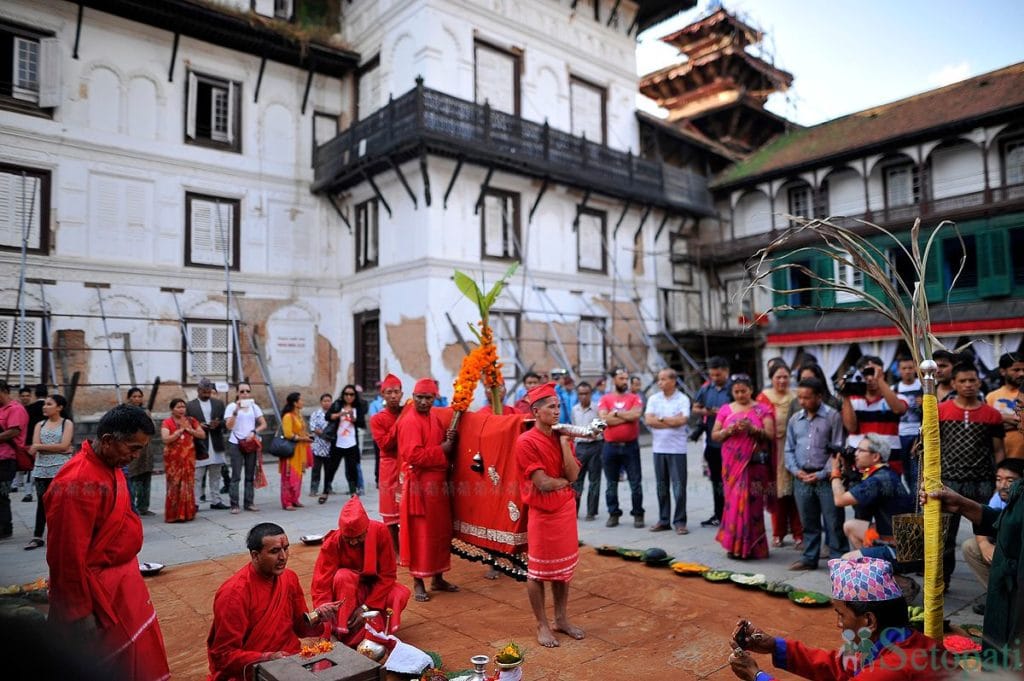Dashain festival is one of the major celebrations of Hindus in Nepal. And on the seventh day of the Dashain, people celebrate Phulpati. Some people also celebrate this day as Saptami. Phulpati comprises of two words ‘phool’ which means flower and ‘pati’ which means plants. This festival is about bringing the phulpati into the puja room (prayer room). Hence, on this day, people bring nine different types of phulpati home to welcome Dashain. By doing so, all nine types of the Goddess will enter our homes and bless us with happiness, wealth and health.
On the day:
People performing a ritual for the festival of Phulpati. Photo: People of Nepal
People first place Navapatrika (nine leaves) outside the house. After that, they perform Navapatrika Puja.
Inside the Dashain Ghar at Hanuman Dhoka, the Then, it is carried inside the puja room (praying room) on the seventh day.
The Phulpati is kept inside the Dashain Ghar. It is worshiped along with the Jamara planted on Ghatasthapana day. On the 10th day, people take out the Navapatrika from the puja room and immerse it in the Holy River. However, other people also do it on the 15th day with jamara.
The Brahmins celebrate Phulpati festival by carrying royal Kalash, holy jamara, banana stalk and sugar cane tied with red cloth from Gorkha to Kathmandu.
On the day, a major event is also held at the heart of the Kathmandu city, Tundikhel. Army officials fire cannons to celebrate the seventh day of Dashain. The army also performs a parade and stunts as a part of the Phulpati Badhai event. The President and government officials of our country come together every year, on this day, to mark the event.
More about Phulpati:
Members of Guruju Ko Paltan marking phulpati at Hanuman Dhoka, Kathmandu. Screengrab: YouTube
There are specific ingredients to phulpati that represent each Goddess worshiped during Navaratha (nine days of Dashain). The nine ingredients mix of phulpati is navapatrika. Navapatrika consists of kera ko bot, darim, dhanko bala, haledo, manabriksha, kachuki, belpatra, ashok, and jayanti.
Kera ko bot (banana stalk) represents Goddess Brahmani (ब्राम्हणी), who bestows peace to our home. Darim (pomegranate) represents Goddess Rakta Dantika (रक्त दंतिका ) who helps and blesses the worshipper.
In dhanko bala (rice stalk) lives Lakshmi, the Goddess of wealth. Goddess Durga graces the haledo (turmeric plant) and puts an end to obstacles. Goddess Chamunda resides in manabriksha (ginger), who puts end to the evil.
Similarly, the ginger plant represents Goddess Kalika (कालिका) who blesses mankind. Likewise in kachuki (hog plum plant) resides Goddess of Power. Likewise, inside belpatra (Wood Apple Tree) lives Lord Shiva. It is the favorite fruit of Lords Vishnu and Shiva. In the Ashok plant, resides Goddess Sokarahita. And finally, in Jayanti lives God Kartikeya.
All nine plants represent gods and goddesses and all represent good health, wealth and prosperity.
Happy Holidays!!!

